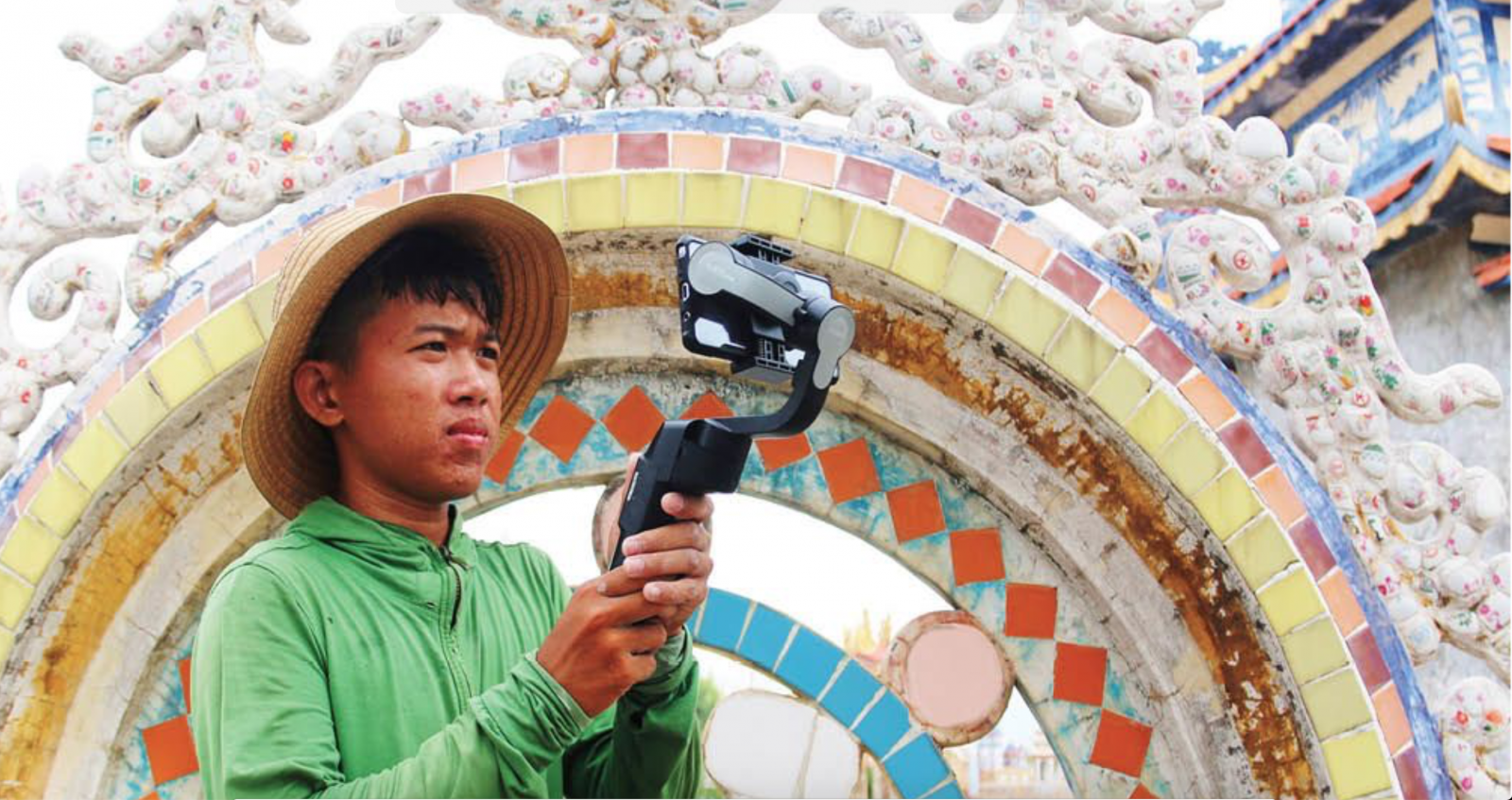
Ho Van Thanh and his work
Maintaining the porcelain mosaic craft
“Are you looking for skilled porcelain mosaic makers? Easy! Follow me.” No sooner had he waited for us to reply than Mr. Tran Tiep (in An Bang Village, Vinh An Commune, Phu Vang District) started his motorbike leading us to the small path toward the sea. Along the road, we saw magnificent tombs decorated with different kinds of dragon and phoenix patterns.
Tiep stopped nearly at the end of the road in front of a pretty large tomb under construction. “This is my clan cemetery. I'm hiring one of the most well-known porcelain mosaic makers from the Vinh Thanh commune to build the tomb and decorate it with porcelain mosaics. Come here and I will introduce you,” said Tiep, leading me inside.
I discovered Tiep was an overseas Vietnamese in the US and he was hiring a group of workers to build tombs for his family in An Bang, a coastal village well known as a tourist site called “The City of Tombs” and commented by the Daily Mail (UK) as “colorful and sumptuous.”
He took me to meet a middle-aged man with his skin darkened by the sun. It was Ho Van Thanh, 48 years old, living in Vinh Thanh Commune, Phu Vang District. Quickly wiping sweat from his face with a wide-brimmed hat, Thanh said he had been in love with this "high-class" job for more than 30 years now.
As a young man, Ho Van Thanh was fascinated with colorful floral patterns painted on porcelain bowls and vases. Because of that passion, Thanh learnt to make porcelain mosaics with a mosaic maker who in the past had worked on royal constructions in the Imperial City. After the decline of the Nguyen Dynasty, his master wandered outside and earned his living by building and repairing communal houses and houses.
“At that time, people were poor and my job was just building houses; few people asked me to make porcelain mosaics. The craft just began to revive 20 years ago when people's lives have gradually improved, especially thanks to money sent by the overseas Vietnamese,” said Thanh.

Working with care

Ho Van Thanh is working meticulously on a porcelain phoenix mosaic
To create lively dragon and phoenix patterns, the artisan firstly makes concrete shapes. Everything including eyes, dragon scales, phoenix feathers, etc., are all made of cement with a small trowel.
Next comes choosing bright and vibrant ceramic, porcelain, and glass pieces. Usually they come from broken bowls, vases, and beer bottles. Usually, grey blue or green is dominated while red, pink, and other warm colors are used to make dragon and phoenix eyes.

Ho Van Thanh is buying ceramic and porcelain vases and bowls with suitable patterns for mosaics on constructions.
Having chosen right colors, the artisan cut porcelain pieces carefully and neatly with a small cutting pliers so that they match patterns on the relief.
The difficulty thing of this stage is how to cut pieces of porcelain to fit patterns that need to be covered. This is done with moderate force; if not, pieces of porcelain are broken; then it must be done all again,” said Thanh.
In the past, porcelain mosaic makers used a special mixture made from oyster shells, molasses, and leaves to stick porcelain pieces onto the relief. Now they use cement instead.
According to Thanh, it often takes from 1-3 months to complete a construction at the An Bang cemetery, depending on the construction size and the skillfulness of the makers. Some complex constructions require thousands of porcelain pieces of various colors, shapes, and types, and they takes months to finish.
Passing down the craft
According to Thanh, there was the time when this porcelain mosaic craft sank into oblivion due to difficulties in life. At the time few people thought about beauty. It is his love for beauty that inspired him to take this weather-beaten craft.
He can now not only live happily, but also live well with his well-paid job. He earns even more when working on tombs that worth up to billions of Vietnamese dongs each, enough money for him to raise his five children.
Thanh and his team have built many tombs, temples, and clan temples in Quang Binh, Quang Tri, and many other provinces in the North.
Luckily for Thanh, his eldest son Ho Van Minh decided to follow in his father’s footsteps. Although he is now only 21 years old, Minh works as the “main craftsman" for many porcelain mosaics.

Ho Van Minh always brings a camera with him to shoot videos for his vlog on YouTube
“I’ve set up a YouTube channel about interesting destinations in Phu Vang district such as the “City of Tombs,” the Vinh Thanh beach, etc. I hope to introduce them to many people,” said Minh.
“I’m very happy to see that my son is eager to learn and wants to follow in his father's footsteps. This job is hard, but I earn good salary, much more than “normal” builders. But more importantly, the craft is passed down to the next generation,” confided Thanh.

Ho Van Thanh and his son beside the gate of a temple decorated with porcelain mosaics made by him
The royal art of porcelain mosaics has been present in Hue since the 17th century and has its origin from outside in the community. With time, this art form appeared on royal constructions and became one of the unique art forms of the Nguyen dynasty.
According to Dr. Phan Thanh Hai, Director of the Provincial Department of Culture and Sports, in Hue, the art of porcelain mosaics has reached its pinnacle at the places such as Thai Hoa Palace, Tu Duc Mausoleum, Khai Dinh Mausoleum, etc.
Story and photos: NHAT ANH